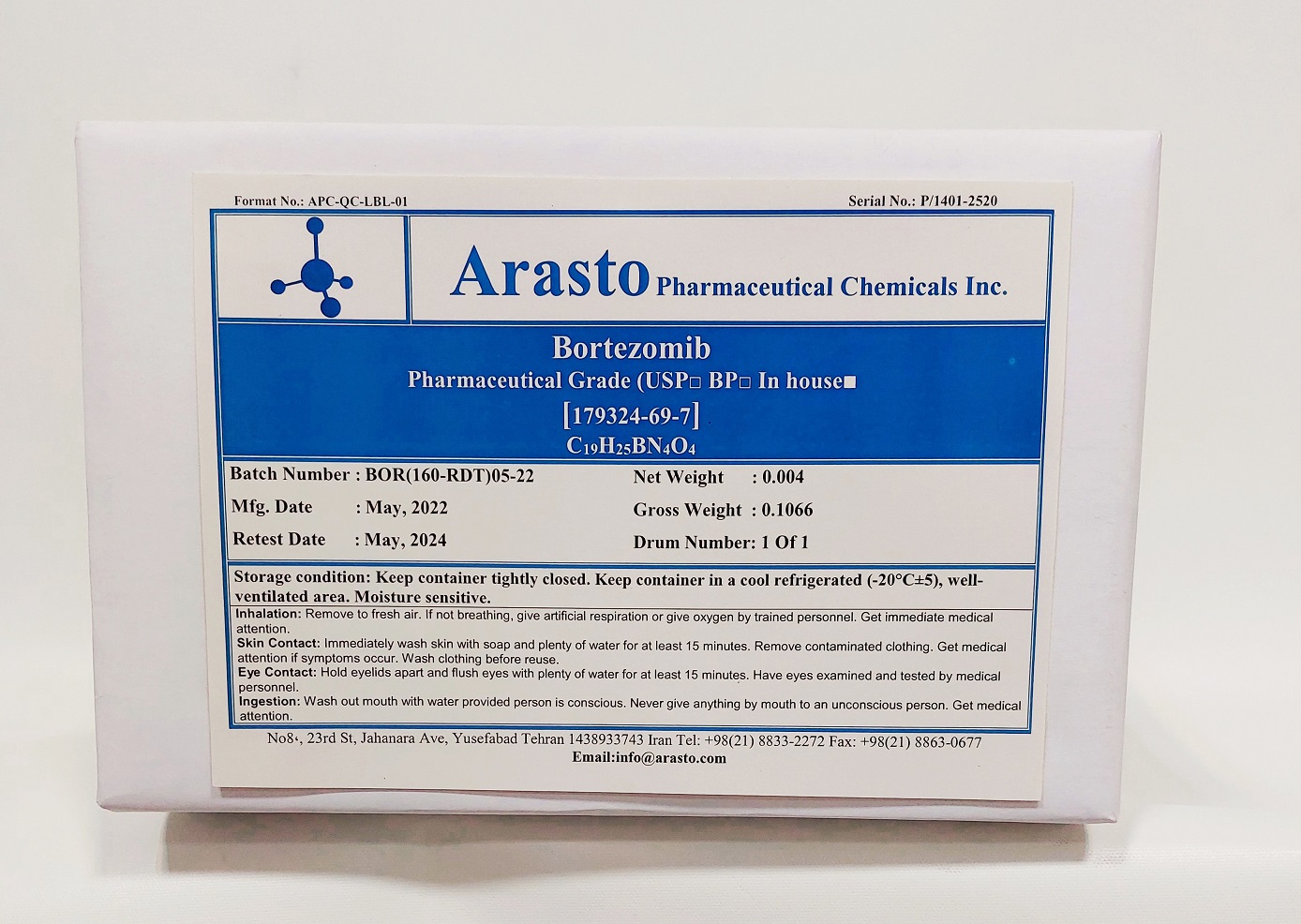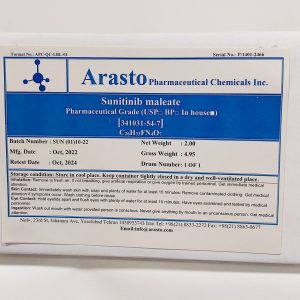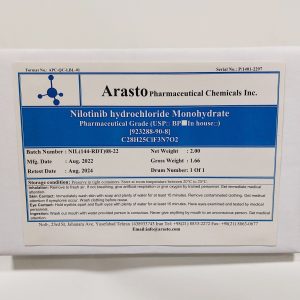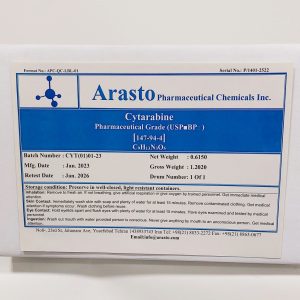توضیحات
Description
(In-house)
- Drug Substance General Information (ICH 3.2.S.1)
1.1. Nomenclature (ICH 3.2.S.1.1)
International non-proprietary name: Bortezomib (Brand Name: Velcade, Millenium Pharmaceuticals (Takeda), USA
Compendial name: Bortezomib
Chemical name: [(1R)-3-methyl-1-({(2S)-3-phenyl-2-[(pyrazin-2-ylcarbonyl)amino]propanoyl}amino)butyl]boronic acid
Arasto’s code: BOR
CAS Registry Number: [179324-69-7]
- Drug Substance General Information (ICH 3.2.S.1)
1.2 Structure (ICH 3.2.S.1.2)
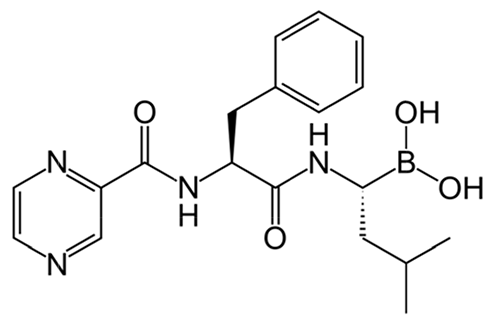
Empirical formula: C19H25BN4O4
Molecular Weight: 384.237 g/mol
- Drug Substance General Information (ICH 3.2.S.1)
1.3.General Properties (ICH 3.2.S.1.3)
Bortezomib is a white crystalline substance. It is soluble in neutral water and polar organic solvents. It is used in injectable form for the treatment of multiple myeloma and cell lymphoma (http://www.velcade.com/). Boronic acids have a pKa range of 9-10. It has been suggested that mannitol (used as excipient in lyophilization of bortezomib) affords the boric acid ester with a lower pKa value of about 6 (http://kuscholarworks.ku.edu/dspace/bitstream/1808/1143/ 1/PS02%2 Marinaro.pdf). It has been reported to have a lop P of 1.53 (https://go.drugbank.com/drugs/DB00188) Bortezomib is not stable in acid or base (see Stability Studies).Bortezomib is reported to be highly toxic: <2 mg/kg IV rats and mice (http://ncifrederick.cancer.gov/rtp/LASP/intra/forms/msds/msds_bortezomib.pdf).
The determination of purity and assay of APIs require comparison of the product with their respective Reference Standards (RS) and Related Compounds (RC or known impurities). Accordingly, ICH regulations on the purity and assay of reference standard and related compounds are clearly defined and must be followed by drug substance and drug product manufacturers.
According to ICH Q7, 11.1 there are 3 types of standards. This is summarized in the following chart and discussed in detail below.

The impurities provided in the following table represent Secondary Reference Standards (SRS) that are prepared in-house by synthesis or by isolation. Each SRS has undergone extensive characterization (IR, UV, 1HNMR, 13CNMR. Mass Spec) and determination of its purity and assay (HPLC). For specification of the SRS of those products that have a monograph, the SRS is compared with a pharmacopoeia Primary Reference Standard (UV, HPLC retention time). For specification of those products that do not have a monograph (known as House Primary Standard), we compare their UV ε or ג /max, IR major absorptions, 1HNMR d (ppm) , 13 CNMR d (ppm) or HPLC retention time with values reported in the chemical literature for these compounds.
Bortezomib In-house Related Compounds
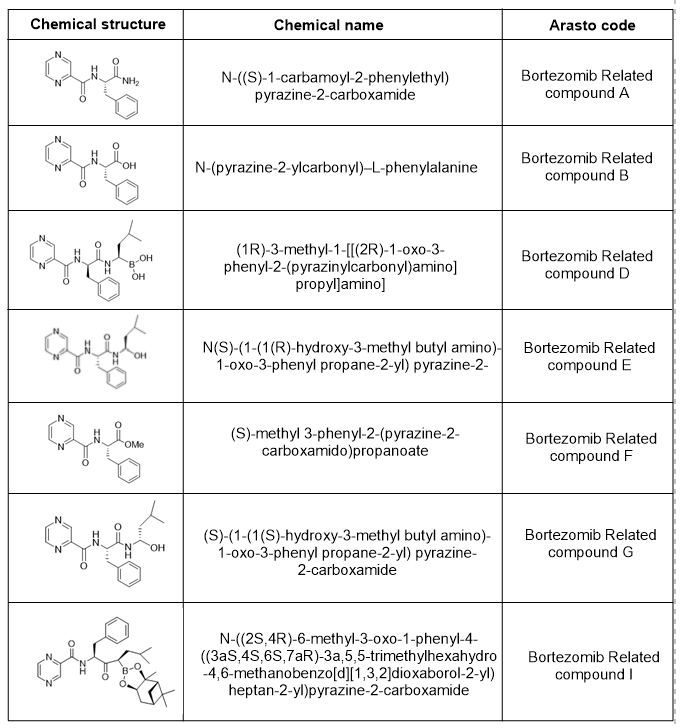
- Primary and Secondary Reference Standard (ICH 3.2.S.5)
5.1. Active Pharmaceutical Ingredient
Primary Reference Standard for bortezomib is not available from United States Pharmacopoeia. We will use a House Primary Standard (previously referred to as Working Standard) for direct control of all batches of bortezomib.
As per ICH (Q7, 11.1) and ICH (Q6, 2.11, 3.2, 3.3)House Primary Standards, which include the API and its Related Compounds, must be examined for their proof of structure (characterization), assay and purity and specification (identification by comparison). Furthermore, ICH Guideline on the Preparation of Common Technical Document (Q4M) requires that the data obtained from characterization, assay and purity and specification must be included in section 3.2.S.3.2 for Related Compounds (already discussed in that section) and section 3.2.S.5 of the DMF for the API. To this end, the House Primary Standard of the API bortezomib has undergone extensive characterization (UV, IR, 1 H NMR, 13C NMR, Mass Spec) to assure its structure, assay and purity (HPLC and/or titration) and specification .
The House Primary Standard for bortezomib was produced from a released batch of bortezomib by subjecting it to an additional crystallization from the final solvent system used in the production of the API to avoid the possibility of other polymorph formation. It was crystallized twice more to ensure high level of purity.
PECIFICATION OF ANALYSIS
| Product: Bortezomib | CAS No.: 179324-69-7 | Spec. No.: APC-QC-SPEC-373-00 | ||
| Issue Date: Apr, 2023 | Valid up to: Apr, 2024 | Reference: In-house | ||
| Tests | Specifications | |||
| Appearance | White to off – white crystalline powder. | |||
| Solubility | Soluble in methanol ,dimethyl sulfoxide. Practically insoluble, or insoluble in water. | |||
| Identification | A: IR, conforms to standard. B: Retention time of the principle peak obtained with chromatogram of sample preparation should correspond to the standard preparation under test assay. | |||
| Appearance of solution | Clear and colorless (1.0% Solution in methanol) | |||
| pH | Between 2.0 to 6.5 (1.0% Suspension in water) | |||
| Specific Rotation | Between -49.5 º to – 57.0° | |||
| Water Content | Between 6.0 to 9.0% | |||
| Heavy metals | NMT 20 ppm | |||
| Chromatographic Purity | Bortezomib Related Compound A: NMT 0.1% Bortezomib Related Compound B: NMT 0.1% Bortezomib Related Compound D: NMT 0.1% Bortezomib Related Compound E: NMT 0.1% Bortezomib Related Compound F: NMT 0.1% Bortezomib Related Compound G: NMT 0.1% Bortezomib Related Compound I: NMT 0.1% Any unspecified impurity: NMT 0.1% Total impurities: NMT 0.5% | |||
| Residual Solvents | Methanol: Max. 3000 ppm (Class II) Ethanol: Max. 5000 ppm (Class ІІІ) Ethyl acetate: Max. 5000 ppm (Class ІІІ) Isopropanol: Max. 5000 ppm (Class ІІІ) Dichloromethane: Max. 600 ppm (Class II) n- Heptane: Max. 5000 ppm (Class III) Toluene: Max. 890 ppm (Class II) methyl tert-butyl ether: Max. 5000 ppm (Class III) Acetone: Max. 5000ppm (Class III) | |||
| Assay | 98.0% to 102.0% | |||
| Microbial limit test (MLT) Total aerobic Microbial count Total Yeast and Moulds count Test of pathogen 1. E. Coli 2. Pseudomonas .aeroginosa 3. Salmonella Species 4. Staphylococcus aureus Endotoxin Limit | NMT 250 CFU/g NMT 50 CFU/g Should be Absent Should be Absent Should be Absent Should be Absent Max. 16 EU per mg | |||
| Prepared by: M. Shahbazi, B.Sc.Chem. | Checked by: A. Forghani, B.Sc.Chem. | |||
| Approved by: F. Javadizadeh, M.Sc.Chem. | ||||
| Storage: Keep container tightly closed. Keep container in a cool refrigerated (-20°C±5), well-ventilated area. Moisture sensitive. | ||||

